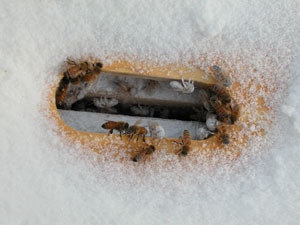 You've seen me going on and one about the two main winter beekeeping issues around here: food stores and mites. This is the most interesting picture I could show you about how I've been trying to look after both.
You've seen me going on and one about the two main winter beekeeping issues around here: food stores and mites. This is the most interesting picture I could show you about how I've been trying to look after both.This is a peek through the inner cover of the Wilde colony on my roof. The bees inside are covered in powdered sugar, and the cover itself is holding about 4 pounds of granulated cane sugar. The powdered sugar is a non-toxic mite control method: the varroa mites seem to be unable to hang onto powdered bees, and they fall off (hopefully leaving the lives of the bees altogether). The bees soon clean themselves off, and get a bit of a snack in the bargain. MaryEllen (the beekeeper, not the colony) points out that this method is kind of like flossing your teeth, though: you need to do it over and over to get much benefit.
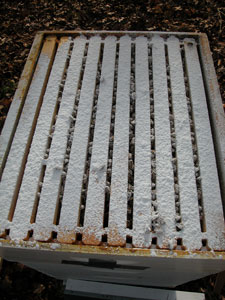 Very soon after sugaring up the bees, white-covered bees began emerging from the hive entrances, though this is just a close up from the top of a hive. To properly apply the sugar, you should remove each box, powder the top, place the next box on top, powder it, and so on. I am afraid to manipulate the bees much in cold weather: I could break the cluster, or expose the queen, or do some other typically awkward thing at a time when the bees have few options. So, for the sake of doing something, I put on the powder and then made another oxalic acid application.
Very soon after sugaring up the bees, white-covered bees began emerging from the hive entrances, though this is just a close up from the top of a hive. To properly apply the sugar, you should remove each box, powder the top, place the next box on top, powder it, and so on. I am afraid to manipulate the bees much in cold weather: I could break the cluster, or expose the queen, or do some other typically awkward thing at a time when the bees have few options. So, for the sake of doing something, I put on the powder and then made another oxalic acid application. 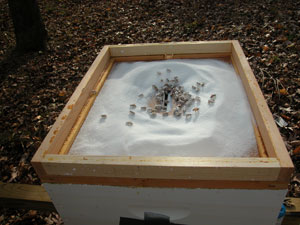 The granulated sugar is a winter feeding method suggested by a beekeeper at the state meeting last month. Bees often stop taking sugar syrup when the temperature reaches freezing, but they will (apparently) creep up on the inner cover and grab some dry sugar when the need arises. You can put a shim on top of the cover, and then place the telescoping cover. I'm a little unsure of whether this is worthwhile, for a couple of reasons. The first is that I don't personally know any beekeeper who does this, and the second is that the bees will need some source of liquid water in order to access the sugar as a food source. This latter is also a concern when offering them fondant (bee candy), however, and I know that they take fondant just fine.
The granulated sugar is a winter feeding method suggested by a beekeeper at the state meeting last month. Bees often stop taking sugar syrup when the temperature reaches freezing, but they will (apparently) creep up on the inner cover and grab some dry sugar when the need arises. You can put a shim on top of the cover, and then place the telescoping cover. I'm a little unsure of whether this is worthwhile, for a couple of reasons. The first is that I don't personally know any beekeeper who does this, and the second is that the bees will need some source of liquid water in order to access the sugar as a food source. This latter is also a concern when offering them fondant (bee candy), however, and I know that they take fondant just fine.As an example, here are two pictures of fondant. The first is a flower-shaped (broken) brick of bee candy newly placed on the Cockrill hive at the mill. The second is a picture of a brick of fondant MaryEllen put on the neighboring Millard hive a week or so before. Chew chew chew!
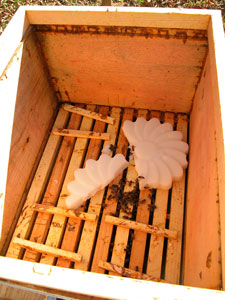
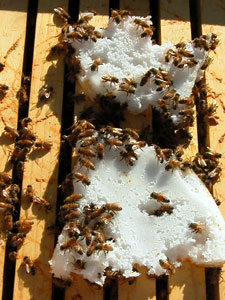
At the state meeting, the most experienced beekeepers agreed about one thing, as winter approaches: after 100 million years, bees don't freeze to death during winter, they starve. We've had warm temperatures, and I have seen bees flying almost every day and only the rarest of flowers in bloom. Though applying the oxalic acid to save the bees from mites will require 15 unique applications, it appears that far more of my time will be spent this year dishing out the sugar.
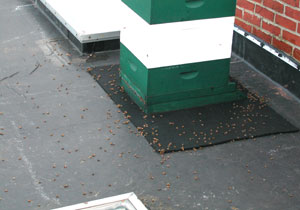
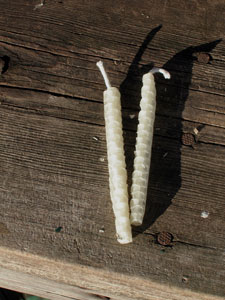 Surprise, surprise: the bees are the lens through which I see the midwinter festivities now, and our celebrations are brightened (even literally) by the bees' presence and presents.
Surprise, surprise: the bees are the lens through which I see the midwinter festivities now, and our celebrations are brightened (even literally) by the bees' presence and presents.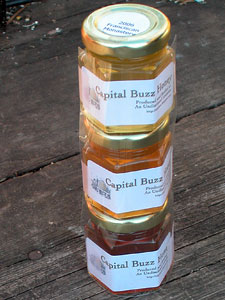 But we have an equal opportunity attitude to holidays around here, so I was also noodling around with bee-based gift baskets, and figured out an interesting way to present the three different colors of honey produced by the roof, monastery, and mill apiaries this year. MaryEllen gave me some special pastry plastic, and I taped together "flights" of honey: the lightest from the monastery, the medium from the roof, and the darkest from the mill. I also labeled some single-source jars for people whom might just like to have a usable amount of a single honey (rather than three somewhat impractical samples).
But we have an equal opportunity attitude to holidays around here, so I was also noodling around with bee-based gift baskets, and figured out an interesting way to present the three different colors of honey produced by the roof, monastery, and mill apiaries this year. MaryEllen gave me some special pastry plastic, and I taped together "flights" of honey: the lightest from the monastery, the medium from the roof, and the darkest from the mill. I also labeled some single-source jars for people whom might just like to have a usable amount of a single honey (rather than three somewhat impractical samples). 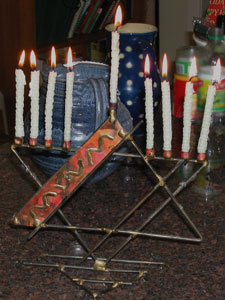 With apologies for the blown-out quality of these pictures, here's our final result. The menorah looked homey and glorious with the beeswax candles, though they did not burn as long as expected. The gift baskets included honey, candles, soaps, and a bag of Honey Pecan "Crackerjack," a first-time thing for me that seems to have come out OK. The recipe is below (with instructions about embellishments in parentheses).
With apologies for the blown-out quality of these pictures, here's our final result. The menorah looked homey and glorious with the beeswax candles, though they did not burn as long as expected. The gift baskets included honey, candles, soaps, and a bag of Honey Pecan "Crackerjack," a first-time thing for me that seems to have come out OK. The recipe is below (with instructions about embellishments in parentheses).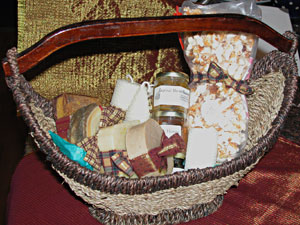 All this craftiness was intended to simplify and refocus this special time, though it must be said that gift baskets are way more time consuming and kitchen-destroying than a trip to the mall. It's hard not to hope rather TOO hard that people will particularly like the effort, and perhaps to get too personally wrapped up in it all. After all, even when the goodies come from the girls, it is not about the stuff.
All this craftiness was intended to simplify and refocus this special time, though it must be said that gift baskets are way more time consuming and kitchen-destroying than a trip to the mall. It's hard not to hope rather TOO hard that people will particularly like the effort, and perhaps to get too personally wrapped up in it all. After all, even when the goodies come from the girls, it is not about the stuff.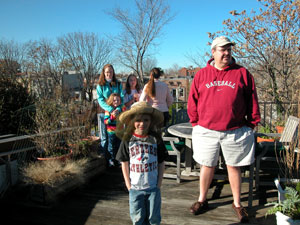
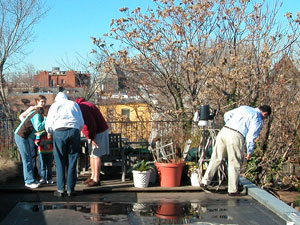
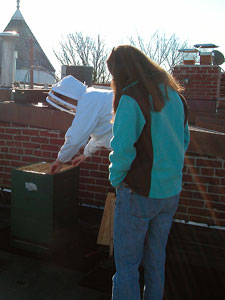 Both of my cousins, Maria (shown here) and Anna (taking the picture) are teachers, and they immediately expressed interest in the bees as a learning tool for kids (I guess it's genetic for us to immediately decide "the kids gotta hear about this!") As I went back to put away the honey frame, Maria came along to take a peek. Note the lack of veil, fear, gloves, etc. She even leaned over and took a good long sniff of wonderful bee essence. One of my favorite things, and something missed in winter, is the warm sweet cloud of scent that wafts up whenever you open a beehive. Now she knows what I mean, too.
Both of my cousins, Maria (shown here) and Anna (taking the picture) are teachers, and they immediately expressed interest in the bees as a learning tool for kids (I guess it's genetic for us to immediately decide "the kids gotta hear about this!") As I went back to put away the honey frame, Maria came along to take a peek. Note the lack of veil, fear, gloves, etc. She even leaned over and took a good long sniff of wonderful bee essence. One of my favorite things, and something missed in winter, is the warm sweet cloud of scent that wafts up whenever you open a beehive. Now she knows what I mean, too.
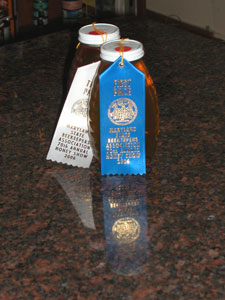 Blue comes in a coupla forms, actually. First, something I meant to mention this weekend: on Saturday, we had the state beekeeping association meeting, complete with a mini honey show. After scoping out whether there were any ants present, the judges gave the monastery honey a first in the beginner category for light color. The rooftop honey got a third for medium color in the same category. It is beginning to granulate, actually (more reason to eat it right away). This makes my collection of ribbons include a second (in a class of two), two fourths (in a class of four and of five), a third, and a first – a complete set, the last two actually meaning something. Interestingly, the wife of the judge who gave me the fourths said that
Blue comes in a coupla forms, actually. First, something I meant to mention this weekend: on Saturday, we had the state beekeeping association meeting, complete with a mini honey show. After scoping out whether there were any ants present, the judges gave the monastery honey a first in the beginner category for light color. The rooftop honey got a third for medium color in the same category. It is beginning to granulate, actually (more reason to eat it right away). This makes my collection of ribbons include a second (in a class of two), two fourths (in a class of four and of five), a third, and a first – a complete set, the last two actually meaning something. Interestingly, the wife of the judge who gave me the fourths said that  In August of last year, roofers next door outed the bees to our south-side neighbors, resulting in just 4 months of undetected beekeeping. Luckily, those neighbors are a little paranoid, too; they also thought the bees were cool, and decided to keep the matter to themselves. Then, this Spring, the north side neighbor got a new roof, and I became really worried, because Kathy is a normal, well-adjusted person with children and her reactions would therefore be alien to me. But it turns out that her roofers never told her, and as a result I outed myself last month (sort of) and she was kind of happy about the whole thing.
In August of last year, roofers next door outed the bees to our south-side neighbors, resulting in just 4 months of undetected beekeeping. Luckily, those neighbors are a little paranoid, too; they also thought the bees were cool, and decided to keep the matter to themselves. Then, this Spring, the north side neighbor got a new roof, and I became really worried, because Kathy is a normal, well-adjusted person with children and her reactions would therefore be alien to me. But it turns out that her roofers never told her, and as a result I outed myself last month (sort of) and she was kind of happy about the whole thing.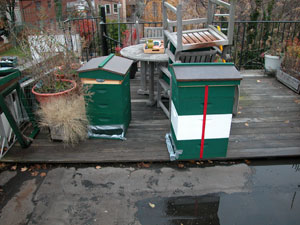 But you might be asking, what about the bees today? Well, they had to be moved onto the deck (which is not being messed with) and they had to be sealed in, because otherwise they would get lost.
But you might be asking, what about the bees today? Well, they had to be moved onto the deck (which is not being messed with) and they had to be sealed in, because otherwise they would get lost.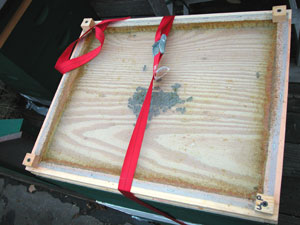 So last night, after sunset (when all the field bees should be back home) I went up and blocked the entrances with plastic window screen material and duct tape, and covered the top with a screen that is usually used for added summer ventilation. Then you run a
So last night, after sunset (when all the field bees should be back home) I went up and blocked the entrances with plastic window screen material and duct tape, and covered the top with a screen that is usually used for added summer ventilation. Then you run a 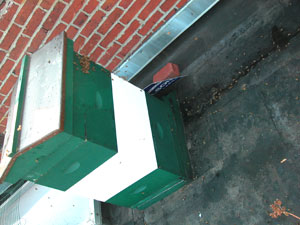 Yesterday was another feeding day, and Twain was the lucky colony... well, sort of. Remember how there seems to be a lot of bees robbing bees this year? Maybe I know why.
Yesterday was another feeding day, and Twain was the lucky colony... well, sort of. Remember how there seems to be a lot of bees robbing bees this year? Maybe I know why.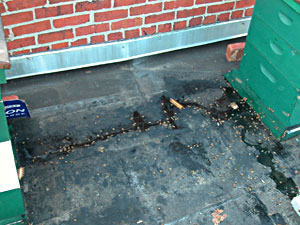 Robbing bees make a different noise than your usual buzzing, and they tend to land all over you, checking to see if perhaps YOU might be a sticky pool of undeserved sugar forming directly in front of them. It's hard to move around without crushing bees, and besides the sadness of that, crushed bee smell is a motivator to get upset: just what you don't want in the middle of a cloud of over-stimulated felon bees.
Robbing bees make a different noise than your usual buzzing, and they tend to land all over you, checking to see if perhaps YOU might be a sticky pool of undeserved sugar forming directly in front of them. It's hard to move around without crushing bees, and besides the sadness of that, crushed bee smell is a motivator to get upset: just what you don't want in the middle of a cloud of over-stimulated felon bees.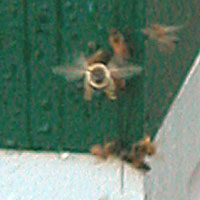 On the up side, while I was wading around the clingy bees, trying to develop a plan, I got a picture of this bee flying at me straight on. I was not trying for her picture: the camera tends to choose its own focal point, and she apparently was it. It's not great, but you can see her antenna on the left if you squint real hard.
On the up side, while I was wading around the clingy bees, trying to develop a plan, I got a picture of this bee flying at me straight on. I was not trying for her picture: the camera tends to choose its own focal point, and she apparently was it. It's not great, but you can see her antenna on the left if you squint real hard. One pot, one kettle, and one ten pound bag of sugar equals a late autumn meal for one hive of bees. As the year winds down, beekeepers who want to ensure that the honeybees have enough stores for the winter mix 2 parts granulated cane sugar to one part hot water in order to make a heavy, honey-like syrup for the bees to sock away in the dwindling days left. The heavier syrup is supposed to signal to the queen that she should stop laying (if she hasn't already: some beekeepers around here say that in our climate she always lays a little through the winter) and the girls should get ready to cluster up and stay warm. By now, the drones are all gone, and things have become serious.
One pot, one kettle, and one ten pound bag of sugar equals a late autumn meal for one hive of bees. As the year winds down, beekeepers who want to ensure that the honeybees have enough stores for the winter mix 2 parts granulated cane sugar to one part hot water in order to make a heavy, honey-like syrup for the bees to sock away in the dwindling days left. The heavier syrup is supposed to signal to the queen that she should stop laying (if she hasn't already: some beekeepers around here say that in our climate she always lays a little through the winter) and the girls should get ready to cluster up and stay warm. By now, the drones are all gone, and things have become serious.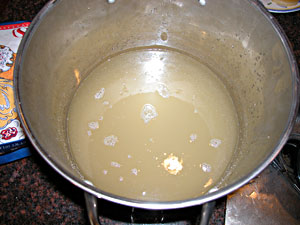 When at loose ends, I make food for the girls. This photo shows what 10 pounds of sugar looks like in about 5 pints of water, just out of the kettle. It's cloudly, and must be stirred for a while. The water must be hot to make such a super-saturated solution, and I boil it before pouring. You must never heat the sugar directly on the burner, however, because the bees cannot digest carmelized sugar and can get potentially deadly dysentery in that manner.
When at loose ends, I make food for the girls. This photo shows what 10 pounds of sugar looks like in about 5 pints of water, just out of the kettle. It's cloudly, and must be stirred for a while. The water must be hot to make such a super-saturated solution, and I boil it before pouring. You must never heat the sugar directly on the burner, however, because the bees cannot digest carmelized sugar and can get potentially deadly dysentery in that manner.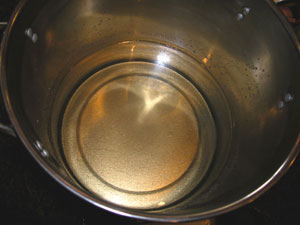 In just ten minutes or so, the mixture becomes crystal clear. It has to cool before you use it, and once it does you sometimes get little floes of sugar ice floating on the top. It helps that my counters are stone and this pot is a thin, cheap one, because I can move it around on the countertop to make it cool faster.
In just ten minutes or so, the mixture becomes crystal clear. It has to cool before you use it, and once it does you sometimes get little floes of sugar ice floating on the top. It helps that my counters are stone and this pot is a thin, cheap one, because I can move it around on the countertop to make it cool faster.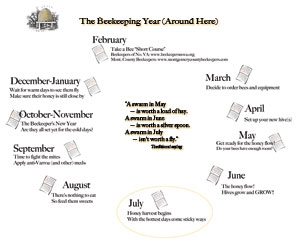
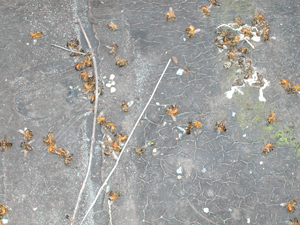 Even though it has been quiet, I look in on the roof bees everyday — hanging around near the entrance, checking on activity levels, looking to see if any deformed bees are around. You see, this time last year the roof was mysteriously covered with bees creeping aimlessly around, and it turned out that the colonies had a raving Varroa infestation.
Even though it has been quiet, I look in on the roof bees everyday — hanging around near the entrance, checking on activity levels, looking to see if any deformed bees are around. You see, this time last year the roof was mysteriously covered with bees creeping aimlessly around, and it turned out that the colonies had a raving Varroa infestation.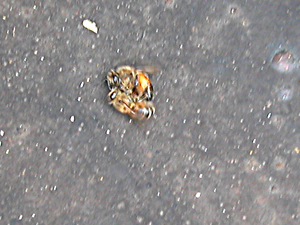 Once bees start to rob, they fight each other like the Dickens at every hive entrance. You can see them rolling around your feet like violent little honey-colored Yin/Yang symbols. They tend to persist, often because the robbing resulted from there being almost nothing else to do!
Once bees start to rob, they fight each other like the Dickens at every hive entrance. You can see them rolling around your feet like violent little honey-colored Yin/Yang symbols. They tend to persist, often because the robbing resulted from there being almost nothing else to do! 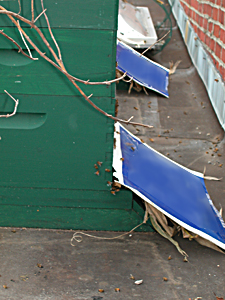 I have only one robbing screen, and two colonies, and it seemed important to balance my response so one colony would not get the advantage over the other. So I went downstairs to seek further guidance from the maarec.cas.psu.edu website, a place of great wisdom. One pamphlet there suggested throwing grass or other plant material over the reduced entrances, making them easier to defend, and/or placing a long board lengthwise across the entrance area, requiring a longer, more complicated, and (once again) more defensible approach path.
I have only one robbing screen, and two colonies, and it seemed important to balance my response so one colony would not get the advantage over the other. So I went downstairs to seek further guidance from the maarec.cas.psu.edu website, a place of great wisdom. One pamphlet there suggested throwing grass or other plant material over the reduced entrances, making them easier to defend, and/or placing a long board lengthwise across the entrance area, requiring a longer, more complicated, and (once again) more defensible approach path. 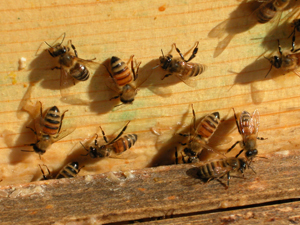 It has been a while since you got to look at a bee picture, so here you go. The year is definitely coming to a close, and my job mostly is to feed sugar syrup and take mite counts.
It has been a while since you got to look at a bee picture, so here you go. The year is definitely coming to a close, and my job mostly is to feed sugar syrup and take mite counts.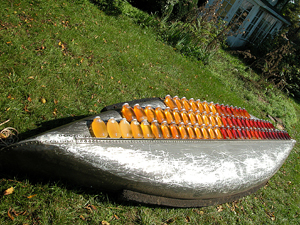 Larry from the beekeeping association ended up putting me in contact with a guy who farms more than 30 kinds of pumpkins, squash, melons, and ... bees! He needed a website for his seasonal business, so with one thing and another I ended up helping him set up satellite broadband and a wireless LAN, as well as a site. I need his permission before I can send you there, though.
Larry from the beekeeping association ended up putting me in contact with a guy who farms more than 30 kinds of pumpkins, squash, melons, and ... bees! He needed a website for his seasonal business, so with one thing and another I ended up helping him set up satellite broadband and a wireless LAN, as well as a site. I need his permission before I can send you there, though.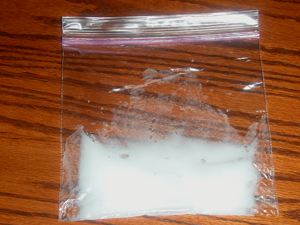 First of all, I want to tell you that the State Bee Inspector came by the historic mill on Tuesday, and he gave us the all-clear on American Foul Brood. In other words, we don't have it, or at least don't have it yet. He pointed out the big mite infestation in my hive there, though, and made various suggestions, including the use of Food Grade Mineral Oil (FGMO) to make those mites go slip-sliding away. I'll probably give it a whirl (there's no harm in it) but I have already completed two oxalic acid fumigations, and will make the third one on Monday. I think I am going to study up on how to double up on mite treatments, without unintentionally poisoning the girls with too much of a good thing.
First of all, I want to tell you that the State Bee Inspector came by the historic mill on Tuesday, and he gave us the all-clear on American Foul Brood. In other words, we don't have it, or at least don't have it yet. He pointed out the big mite infestation in my hive there, though, and made various suggestions, including the use of Food Grade Mineral Oil (FGMO) to make those mites go slip-sliding away. I'll probably give it a whirl (there's no harm in it) but I have already completed two oxalic acid fumigations, and will make the third one on Monday. I think I am going to study up on how to double up on mite treatments, without unintentionally poisoning the girls with too much of a good thing.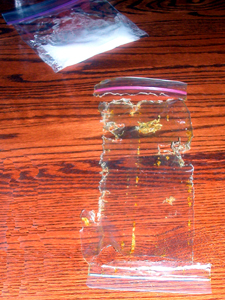 This picture shows such a bag two weeks later, The girls have cleaned it off, and actually started chewing the bag. The yellow stuff is propolis (no Carniolan party is ever complete without propolis). As of today, they got a chance to start over on a second and final dose.
This picture shows such a bag two weeks later, The girls have cleaned it off, and actually started chewing the bag. The yellow stuff is propolis (no Carniolan party is ever complete without propolis). As of today, they got a chance to start over on a second and final dose. 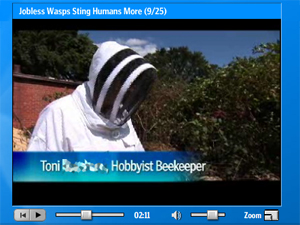
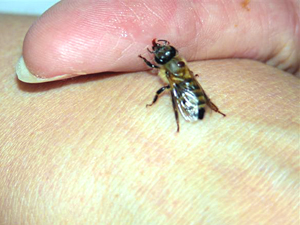
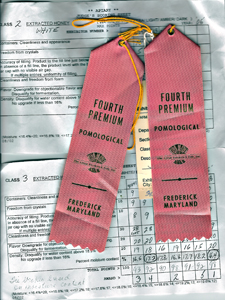 It appears that a foolish consistency sort of inhabits this beekeeper's brain, because both the Monastery and the Rooftop honey have won the same ranking, fourth place, at a nearby county fair. And yes, one of them was fourth place in a field of four! Now, if I had managed to keep the ANT out of my rooftop entry, there was a chance I could have tied for first or earned second...
It appears that a foolish consistency sort of inhabits this beekeeper's brain, because both the Monastery and the Rooftop honey have won the same ranking, fourth place, at a nearby county fair. And yes, one of them was fourth place in a field of four! Now, if I had managed to keep the ANT out of my rooftop entry, there was a chance I could have tied for first or earned second...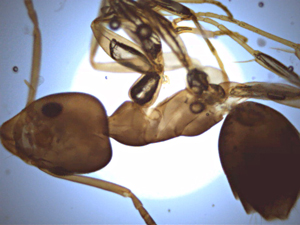 Here she is, the interloper. Like a true friend, MaryEllen maintains that the ant must have crawled in during the judging, but I know that honey extracting brought me a temporary scourge of the critters... I also, shortly thereafter, admitted to needing reading glasses. So, put 2 and 2 together, and you get...fourth.
Here she is, the interloper. Like a true friend, MaryEllen maintains that the ant must have crawled in during the judging, but I know that honey extracting brought me a temporary scourge of the critters... I also, shortly thereafter, admitted to needing reading glasses. So, put 2 and 2 together, and you get...fourth.
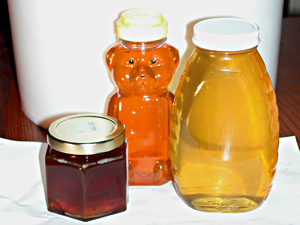 This post actually started seven days ago, when I finally extracted my first true harvest of rooftop honey. On Thursday, September 7, I finally went upstairs to see what was what, thinking that I could have anything from 80 to 200 pounds of honey up there. This was a daunting prospect, because it meant removing bees from seven or more supers, and hauling each (weighing anything from 30 to 85 pounds, depending) down a spiral staircase, across the second floor of the house, down the stairs to the first floor, then back across the house to the kitchen. And no MaryEllen around to make things easy this time!
This post actually started seven days ago, when I finally extracted my first true harvest of rooftop honey. On Thursday, September 7, I finally went upstairs to see what was what, thinking that I could have anything from 80 to 200 pounds of honey up there. This was a daunting prospect, because it meant removing bees from seven or more supers, and hauling each (weighing anything from 30 to 85 pounds, depending) down a spiral staircase, across the second floor of the house, down the stairs to the first floor, then back across the house to the kitchen. And no MaryEllen around to make things easy this time!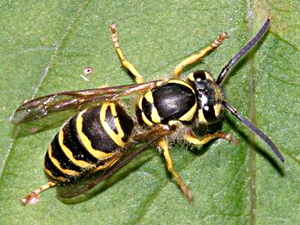
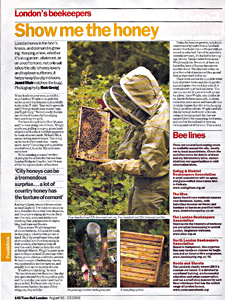

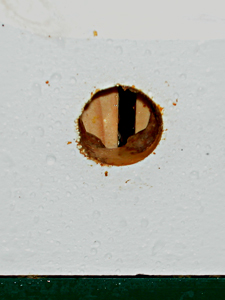 While working here today, the rain gauge on the roof informed me that today, September first, we have just received twice as much rain as we did during the entire month of August. Far from using this as an (admittedly tempting) opportunity to kvetch about the weather, I'd like to thank you intrepid urban gardeners out there...the ones who planted salvia, chives, lavender, Russian sage, crepe myrtle, augustache, Japanese Pagoda trees, and those few other late-summer bloomers that offer up nectar and life to the bees. And even more, who water them more per acre than any farmer could.
While working here today, the rain gauge on the roof informed me that today, September first, we have just received twice as much rain as we did during the entire month of August. Far from using this as an (admittedly tempting) opportunity to kvetch about the weather, I'd like to thank you intrepid urban gardeners out there...the ones who planted salvia, chives, lavender, Russian sage, crepe myrtle, augustache, Japanese Pagoda trees, and those few other late-summer bloomers that offer up nectar and life to the bees. And even more, who water them more per acre than any farmer could. 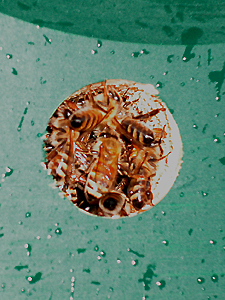 The wind has been whipping fiercely, too (over 30 MPH around 3 PM), so I went up to look at the girls, and this is where today's pictures come from. You may remember that I drilled extra entrance/exit and ventilation holes in many of my hive boxes to spare the girls extra work in coming, going, and cooling the hive. When I went up to peer into the holes on the windward side today, I saw no bees, and could not even arouse a guard bee's interest by sticking in a finger. This was worrying. Checking the wall-ward side of the hive, there were the girls, mighty crowded, too. The wind was affecting them badly, and they were trying to get far from it.
The wind has been whipping fiercely, too (over 30 MPH around 3 PM), so I went up to look at the girls, and this is where today's pictures come from. You may remember that I drilled extra entrance/exit and ventilation holes in many of my hive boxes to spare the girls extra work in coming, going, and cooling the hive. When I went up to peer into the holes on the windward side today, I saw no bees, and could not even arouse a guard bee's interest by sticking in a finger. This was worrying. Checking the wall-ward side of the hive, there were the girls, mighty crowded, too. The wind was affecting them badly, and they were trying to get far from it.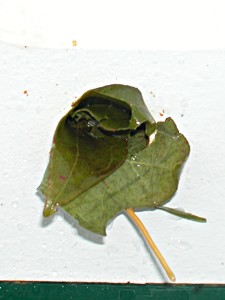 So I searched around the roof to find something with which to temporarily block the holes, and found wind-blown maple and sycamore leaves. The first couple of attempts, using somewhat limp leaves, resulted in near immediate removal. Then some crisper specimens arrived with a blast of rain, and the deed was done. The last picture is the leaf protecting the box with the brood nest.
So I searched around the roof to find something with which to temporarily block the holes, and found wind-blown maple and sycamore leaves. The first couple of attempts, using somewhat limp leaves, resulted in near immediate removal. Then some crisper specimens arrived with a blast of rain, and the deed was done. The last picture is the leaf protecting the box with the brood nest.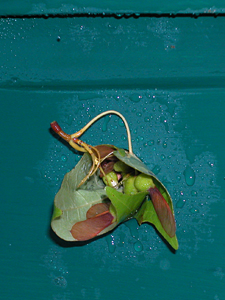 One of my major beekeeping shortcomings is taking counts of varroa mites on a regular basis. The reason for this is not laziness (or so I think). There are two main ways to count mites, one is a mite drop onto a board slid beneath a screen bottom board, and the other is a "sugar shake," where you trap a coupla hundred bees in a mason jar with a screened lid, put in a quarter cup or so of confectioners sugar, and shake it out over a bowl of water. The sugar knocks mites off of the bees, and the water makes it easy to count them as they drop. On a board, you just put it in, wait three days, pull it out, count mites, and divide by three.
One of my major beekeeping shortcomings is taking counts of varroa mites on a regular basis. The reason for this is not laziness (or so I think). There are two main ways to count mites, one is a mite drop onto a board slid beneath a screen bottom board, and the other is a "sugar shake," where you trap a coupla hundred bees in a mason jar with a screened lid, put in a quarter cup or so of confectioners sugar, and shake it out over a bowl of water. The sugar knocks mites off of the bees, and the water makes it easy to count them as they drop. On a board, you just put it in, wait three days, pull it out, count mites, and divide by three. 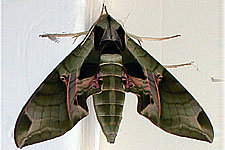 Last year, I posted this picture of a scary-big moth that flew into my house from the garden, and incorrectly called it a "Sphinx Moth," demonstrating my ongoing enthusiasm for, but lack of insight into, our arthropod friends. Well, last month, David M. emailed me with better information, and I thought you might want it, too (though he did not seem to want to receive credit by name).
Last year, I posted this picture of a scary-big moth that flew into my house from the garden, and incorrectly called it a "Sphinx Moth," demonstrating my ongoing enthusiasm for, but lack of insight into, our arthropod friends. Well, last month, David M. emailed me with better information, and I thought you might want it, too (though he did not seem to want to receive credit by name).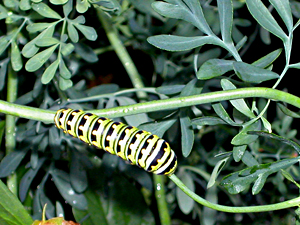 Now it's really cool that he mentioned all those identification resources, because only a month or so before, I had met this critter on a rue plant in the front yard. It turns out to be (probably...I am willing to hear other thoughts!) a Black Swallowtail Butterfly caterpillar. As I write to you today, the butterflies are here in force, making their way to winter pastures. There are many monarchs visiting rose of sharon blossoms, and yes, some Black Swallowtails in the front yard. I'm kind of hoping they did some growing up there.
Now it's really cool that he mentioned all those identification resources, because only a month or so before, I had met this critter on a rue plant in the front yard. It turns out to be (probably...I am willing to hear other thoughts!) a Black Swallowtail Butterfly caterpillar. As I write to you today, the butterflies are here in force, making their way to winter pastures. There are many monarchs visiting rose of sharon blossoms, and yes, some Black Swallowtails in the front yard. I'm kind of hoping they did some growing up there.
 This grey Saturday morning, Sam and I were advised to get out of Londonderry ahead of the Ulstermen's march, so we went off to the
This grey Saturday morning, Sam and I were advised to get out of Londonderry ahead of the Ulstermen's march, so we went off to the 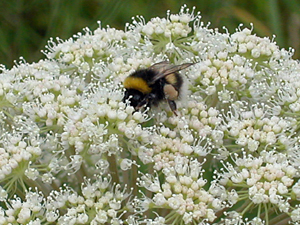 The environment thereabouts is rocky and almost alpine, but there were still several kinds of flowers in bloom, and bees working them. The temperature was only around 16 Celsius, or 60 Fahrenheit, with a steady wind, but the native bees at least were on the job. The bee in this picture is working what might be Scot's Lovage, though I am somewhat unconvinced of this plant identification. This bee is displaying a fine set of cream-colored pollen packs on her back legs, just below the wings.
The environment thereabouts is rocky and almost alpine, but there were still several kinds of flowers in bloom, and bees working them. The temperature was only around 16 Celsius, or 60 Fahrenheit, with a steady wind, but the native bees at least were on the job. The bee in this picture is working what might be Scot's Lovage, though I am somewhat unconvinced of this plant identification. This bee is displaying a fine set of cream-colored pollen packs on her back legs, just below the wings. 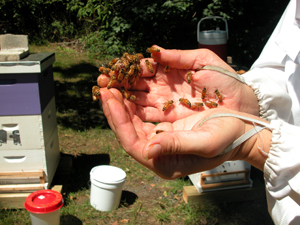 Back on
Back on 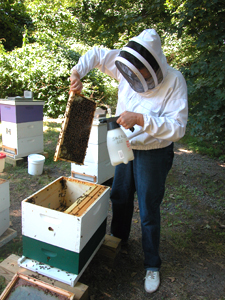 The picture up top shows bees recovering from what I am doing in this picture: spraying sucrocide from a pump sprayer onto each side of every single frame in the hive, as well as the sides. We try not to spray Queen Maud or any open brood. By the way, this exercse has to be repeated 3 times, at one week (or so) intervals. Hard work.
The picture up top shows bees recovering from what I am doing in this picture: spraying sucrocide from a pump sprayer onto each side of every single frame in the hive, as well as the sides. We try not to spray Queen Maud or any open brood. By the way, this exercse has to be repeated 3 times, at one week (or so) intervals. Hard work. 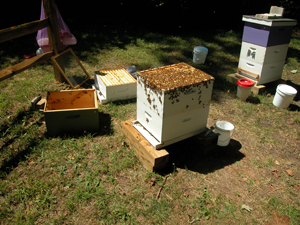 When applying the sucrocide, though, we found ourselves disassembling hives full of bees in hot weather, and reassembling them into hives of sodden bees who just wanted to climb up out of the box to catch some rays and dry off. Kind of a bee-cano, since my colony out there is just brimming with bees, easily a peak sort of population for a hive around here. This picture is actually MaryEllen's colony, though. Those boxes get heavy at midsummer, and they are very heavy to settle down gently, one on top of the other, while trying to gently convince wet bees to move along. Thank goodness we did this together!
When applying the sucrocide, though, we found ourselves disassembling hives full of bees in hot weather, and reassembling them into hives of sodden bees who just wanted to climb up out of the box to catch some rays and dry off. Kind of a bee-cano, since my colony out there is just brimming with bees, easily a peak sort of population for a hive around here. This picture is actually MaryEllen's colony, though. Those boxes get heavy at midsummer, and they are very heavy to settle down gently, one on top of the other, while trying to gently convince wet bees to move along. Thank goodness we did this together!